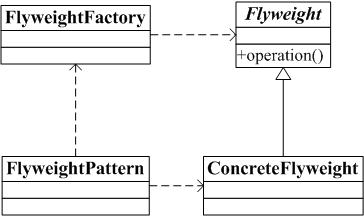GOF:運(yùn)用共享技術(shù)有效地支持大量細(xì)粒度的對(duì)象。
解釋一下概念:也就是說在一個(gè)系統(tǒng)中如果有多個(gè)相同的對(duì)象,那么只共享一份就可以了,不必每個(gè)都去實(shí)例化一個(gè)對(duì)象。比如說(這里引用GOF書中的例子)一個(gè)文本系統(tǒng),每個(gè)字母定一個(gè)對(duì)象,那么大小寫字母一共就是52個(gè),那么就要定義52個(gè)對(duì)象。如果有一個(gè)1M的文本,那么字母是何其的多,如果每個(gè)字母都定義一個(gè)對(duì)象那么內(nèi)存早就爆了。那么如果要是每個(gè)字母都共享一個(gè)對(duì)象,那么就大大節(jié)約了資源。
在Flyweight模式中,由于要產(chǎn)生各種各樣的對(duì)象,所以在Flyweight(享元)模式中常出現(xiàn)Factory模式。Flyweight的內(nèi)部狀態(tài)是用來共享的,Flyweight factory負(fù)責(zé)維護(hù)一個(gè)對(duì)象存儲(chǔ)池(Flyweight Pool)來存放內(nèi)部狀態(tài)的對(duì)象。Flyweight模式是一個(gè)提高程序效率和性能的模式,會(huì)大大加快程序的運(yùn)行速度.應(yīng)用場合很多,下面舉個(gè)例子:
先定義一個(gè)抽象的Flyweight類:
在實(shí)現(xiàn)一個(gè)具體類:
實(shí)現(xiàn)一個(gè)工廠方法類:
下面是運(yùn)行結(jié)果:
下面給出一個(gè)簡易的UML圖:

解釋一下概念:也就是說在一個(gè)系統(tǒng)中如果有多個(gè)相同的對(duì)象,那么只共享一份就可以了,不必每個(gè)都去實(shí)例化一個(gè)對(duì)象。比如說(這里引用GOF書中的例子)一個(gè)文本系統(tǒng),每個(gè)字母定一個(gè)對(duì)象,那么大小寫字母一共就是52個(gè),那么就要定義52個(gè)對(duì)象。如果有一個(gè)1M的文本,那么字母是何其的多,如果每個(gè)字母都定義一個(gè)對(duì)象那么內(nèi)存早就爆了。那么如果要是每個(gè)字母都共享一個(gè)對(duì)象,那么就大大節(jié)約了資源。
在Flyweight模式中,由于要產(chǎn)生各種各樣的對(duì)象,所以在Flyweight(享元)模式中常出現(xiàn)Factory模式。Flyweight的內(nèi)部狀態(tài)是用來共享的,Flyweight factory負(fù)責(zé)維護(hù)一個(gè)對(duì)象存儲(chǔ)池(Flyweight Pool)來存放內(nèi)部狀態(tài)的對(duì)象。Flyweight模式是一個(gè)提高程序效率和性能的模式,會(huì)大大加快程序的運(yùn)行速度.應(yīng)用場合很多,下面舉個(gè)例子:
先定義一個(gè)抽象的Flyweight類:
1 package Flyweight;
package Flyweight;
2
3 public abstract class Flyweight
public abstract class Flyweight
4

5 {
{
6 public abstract void operation();
public abstract void operation();
7 }//end abstract class Flyweight
}//end abstract class Flyweight
 package Flyweight;
package Flyweight;2

3
 public abstract class Flyweight
public abstract class Flyweight4


5
 {
{6
 public abstract void operation();
public abstract void operation();7
 }//end abstract class Flyweight
}//end abstract class Flyweight在實(shí)現(xiàn)一個(gè)具體類:
1 package Flyweight;
package Flyweight;
2
3 public class ConcreteFlyweight extends Flyweight
public class ConcreteFlyweight extends Flyweight
4

5 {
{
6 private String string;
private String string;
7 public ConcreteFlyweight(String str)
public ConcreteFlyweight(String str)
8

9 {
{
10 string = str;
string = str;
11 }//end ConcreteFlyweight(
}//end ConcreteFlyweight( )
)
12
13 public void operation()
public void operation()
14

15 {
{
16 System.out.println("Concrete---Flyweight : " + string);
System.out.println("Concrete---Flyweight : " + string);
17 }//end operation()
}//end operation()
18
19 }//end class ConcreteFlyweight
}//end class ConcreteFlyweight
 package Flyweight;
package Flyweight;2

3
 public class ConcreteFlyweight extends Flyweight
public class ConcreteFlyweight extends Flyweight4


5
 {
{6
 private String string;
private String string;7
 public ConcreteFlyweight(String str)
public ConcreteFlyweight(String str)8


9
 {
{10
 string = str;
string = str;11
 }//end ConcreteFlyweight(
}//end ConcreteFlyweight( )
)12

13
 public void operation()
public void operation()14


15
 {
{16
 System.out.println("Concrete---Flyweight : " + string);
System.out.println("Concrete---Flyweight : " + string);17
 }//end operation()
}//end operation()18

19
 }//end class ConcreteFlyweight
}//end class ConcreteFlyweight實(shí)現(xiàn)一個(gè)工廠方法類:
1 package Flyweight;
package Flyweight;
2 import java.util.Hashtable;
import java.util.Hashtable;
3
4 public class FlyweightFactory
public class FlyweightFactory
5

6 {
{
7 private Hashtable flyweights = new Hashtable();//----------------------------1
private Hashtable flyweights = new Hashtable();//----------------------------1
8 public FlyweightFactory()
public FlyweightFactory()  {}
{}
9
10 public Flyweight getFlyWeight(Object obj)
public Flyweight getFlyWeight(Object obj)
11

12 {
{
13 Flyweight flyweight = (Flyweight) flyweights.get(obj);//----------------2
Flyweight flyweight = (Flyweight) flyweights.get(obj);//----------------2
14
15 if(flyweight == null)
if(flyweight == null)  {//---------------------------------------------------3
{//---------------------------------------------------3
16 //產(chǎn)生新的ConcreteFlyweight
//產(chǎn)生新的ConcreteFlyweight
17 flyweight = new ConcreteFlyweight((String)obj);
flyweight = new ConcreteFlyweight((String)obj);
18 flyweights.put(obj, flyweight);//--------------------------------------5
flyweights.put(obj, flyweight);//--------------------------------------5
19 }
}
20 return flyweight;//---------------------------------------------------------6
return flyweight;//---------------------------------------------------------6
21 }//end GetFlyWeight(
}//end GetFlyWeight( )
)
22
23 public int getFlyweightSize()
public int getFlyweightSize()
24

25 {
{
26 return flyweights.size();
return flyweights.size();
27 }
}
28 }//end class FlyweightFactory
}//end class FlyweightFactory
 package Flyweight;
package Flyweight;2
 import java.util.Hashtable;
import java.util.Hashtable;3

4
 public class FlyweightFactory
public class FlyweightFactory5


6
 {
{7
 private Hashtable flyweights = new Hashtable();//----------------------------1
private Hashtable flyweights = new Hashtable();//----------------------------18
 public FlyweightFactory()
public FlyweightFactory()  {}
{}9

10
 public Flyweight getFlyWeight(Object obj)
public Flyweight getFlyWeight(Object obj)11


12
 {
{13
 Flyweight flyweight = (Flyweight) flyweights.get(obj);//----------------2
Flyweight flyweight = (Flyweight) flyweights.get(obj);//----------------214

15
 if(flyweight == null)
if(flyweight == null)  {//---------------------------------------------------3
{//---------------------------------------------------316
 //產(chǎn)生新的ConcreteFlyweight
//產(chǎn)生新的ConcreteFlyweight17
 flyweight = new ConcreteFlyweight((String)obj);
flyweight = new ConcreteFlyweight((String)obj);18
 flyweights.put(obj, flyweight);//--------------------------------------5
flyweights.put(obj, flyweight);//--------------------------------------519
 }
}20
 return flyweight;//---------------------------------------------------------6
return flyweight;//---------------------------------------------------------621
 }//end GetFlyWeight(
}//end GetFlyWeight( )
)22

23
 public int getFlyweightSize()
public int getFlyweightSize()24


25
 {
{26
 return flyweights.size();
return flyweights.size();27
 }
}28
 }//end class FlyweightFactory
}//end class FlyweightFactory
這個(gè)工廠方法類非常關(guān)鍵,這里詳細(xì)解釋一下:
在1處定義了一個(gè)Hashtable用來存儲(chǔ)各個(gè)對(duì)象;在2處選出要實(shí)例化的對(duì)象,在6處將該對(duì)象返回,如果在Hashtable中沒有要選擇的對(duì)象,此時(shí)變量flyweight為null,產(chǎn)生一個(gè)新的flyweight存儲(chǔ)在Hashtable中,并將該對(duì)象返回。
最后看看Flyweight的調(diào)用:
1 package Flyweight;
package Flyweight;
2 import java.util.Hashtable;
import java.util.Hashtable;
3
4 public class FlyweightPattern
public class FlyweightPattern  {
{
5 FlyweightFactory factory = new FlyweightFactory();
FlyweightFactory factory = new FlyweightFactory();
6 Flyweight fly1;
Flyweight fly1;
7 Flyweight fly2;
Flyweight fly2;
8 Flyweight fly3;
Flyweight fly3;
9 Flyweight fly4;
Flyweight fly4;
10 Flyweight fly5;
Flyweight fly5;
11 Flyweight fly6;
Flyweight fly6;
12
13 /** *//** Creates a new instance of FlyweightPattern */
/** *//** Creates a new instance of FlyweightPattern */
14 public FlyweightPattern()
public FlyweightPattern()  {
{
15 fly1 = factory.getFlyWeight("Google");
fly1 = factory.getFlyWeight("Google");
16 fly2 = factory.getFlyWeight("Qutr");
fly2 = factory.getFlyWeight("Qutr");
17 fly3 = factory.getFlyWeight("Google");
fly3 = factory.getFlyWeight("Google");
18 fly4 = factory.getFlyWeight("Google");
fly4 = factory.getFlyWeight("Google");
19 fly5 = factory.getFlyWeight("Google");
fly5 = factory.getFlyWeight("Google");
20 fly6 = factory.getFlyWeight("Google");
fly6 = factory.getFlyWeight("Google");
21 }//end FlyweightPattern()
}//end FlyweightPattern()
22
23 public void showFlyweight()
public void showFlyweight()
24

25 {
{
26 fly1.operation();
fly1.operation();
27 fly2.operation();
fly2.operation();
28 fly3.operation();
fly3.operation();
29 fly4.operation();
fly4.operation();
30 fly5.operation();
fly5.operation();
31 fly6.operation();
fly6.operation();
32 int objSize = factory.getFlyweightSize();
int objSize = factory.getFlyweightSize();
33 System.out.println("objSize = " + objSize);
System.out.println("objSize = " + objSize);
34 }//end showFlyweight()
}//end showFlyweight()
35
36 public static void main(String[] args)
public static void main(String[] args)
37

38 {
{
39 System.out.println("The FlyWeight Pattern!");
System.out.println("The FlyWeight Pattern!");
40 FlyweightPattern fp = new FlyweightPattern();
FlyweightPattern fp = new FlyweightPattern();
41 fp.showFlyweight();
fp.showFlyweight();
42 }//end main(
}//end main( )
)
43 }//end class FlyweightPattern
}//end class FlyweightPattern
 package Flyweight;
package Flyweight;2
 import java.util.Hashtable;
import java.util.Hashtable;3

4
 public class FlyweightPattern
public class FlyweightPattern  {
{5
 FlyweightFactory factory = new FlyweightFactory();
FlyweightFactory factory = new FlyweightFactory(); 6
 Flyweight fly1;
Flyweight fly1;7
 Flyweight fly2;
Flyweight fly2;8
 Flyweight fly3;
Flyweight fly3;9
 Flyweight fly4;
Flyweight fly4;10
 Flyweight fly5;
Flyweight fly5;11
 Flyweight fly6;
Flyweight fly6;12

13
 /** *//** Creates a new instance of FlyweightPattern */
/** *//** Creates a new instance of FlyweightPattern */14
 public FlyweightPattern()
public FlyweightPattern()  {
{15
 fly1 = factory.getFlyWeight("Google");
fly1 = factory.getFlyWeight("Google");16
 fly2 = factory.getFlyWeight("Qutr");
fly2 = factory.getFlyWeight("Qutr");17
 fly3 = factory.getFlyWeight("Google");
fly3 = factory.getFlyWeight("Google");18
 fly4 = factory.getFlyWeight("Google");
fly4 = factory.getFlyWeight("Google");19
 fly5 = factory.getFlyWeight("Google");
fly5 = factory.getFlyWeight("Google");20
 fly6 = factory.getFlyWeight("Google");
fly6 = factory.getFlyWeight("Google");21
 }//end FlyweightPattern()
}//end FlyweightPattern()22

23
 public void showFlyweight()
public void showFlyweight()24


25
 {
{26
 fly1.operation();
fly1.operation();27
 fly2.operation();
fly2.operation();28
 fly3.operation();
fly3.operation();29
 fly4.operation();
fly4.operation();30
 fly5.operation();
fly5.operation();31
 fly6.operation();
fly6.operation();32
 int objSize = factory.getFlyweightSize();
int objSize = factory.getFlyweightSize();33
 System.out.println("objSize = " + objSize);
System.out.println("objSize = " + objSize);34
 }//end showFlyweight()
}//end showFlyweight()35

36
 public static void main(String[] args)
public static void main(String[] args)37


38
 {
{39
 System.out.println("The FlyWeight Pattern!");
System.out.println("The FlyWeight Pattern!");40
 FlyweightPattern fp = new FlyweightPattern();
FlyweightPattern fp = new FlyweightPattern();41
 fp.showFlyweight();
fp.showFlyweight();42
 }//end main(
}//end main( )
)43
 }//end class FlyweightPattern
}//end class FlyweightPattern下面是運(yùn)行結(jié)果:
1 Concrete---Flyweight : Google
Concrete---Flyweight : Google
2 Concrete---Flyweight : Qutr
Concrete---Flyweight : Qutr
3 Concrete---Flyweight : Google
Concrete---Flyweight : Google
4 Concrete---Flyweight : Google
Concrete---Flyweight : Google
5 Concrete---Flyweight : Google
Concrete---Flyweight : Google
6 Concrete---Flyweight : Google
Concrete---Flyweight : Google
7 objSize = 2
objSize = 2
我們定義了6個(gè)對(duì)象,其中有5個(gè)是相同的,按照Flyweight模式的定義“Google”應(yīng)該共享一個(gè)對(duì)象,在實(shí)際的對(duì)象數(shù)中我們可以看出實(shí)際的對(duì)象卻是只有2個(gè)。 Concrete---Flyweight : Google
Concrete---Flyweight : Google2
 Concrete---Flyweight : Qutr
Concrete---Flyweight : Qutr3
 Concrete---Flyweight : Google
Concrete---Flyweight : Google4
 Concrete---Flyweight : Google
Concrete---Flyweight : Google5
 Concrete---Flyweight : Google
Concrete---Flyweight : Google6
 Concrete---Flyweight : Google
Concrete---Flyweight : Google7
 objSize = 2
objSize = 2 下面給出一個(gè)簡易的UML圖:






